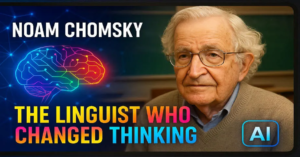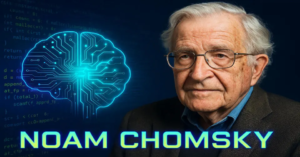Noam Chomsky: The Revolutionary Mind Behind Linguistics, Politics, and Human Cognition
Noam Chomsky: The Linguist Who Rewired Our Understanding of Mind, Language, and Power

For over seven decades, Noam Chomsky has been a tectonic force in multiple intellectual domains. So reshaping linguistics, igniting the cognitive revolution. Then providing a relentless critique of power structures. His journey from a Philadelphia bookstore to MIT lecture halls and global protest movements reveals a mind. So uniquely equipped to decode both the hidden structures of language and the visible machinery of oppression.
Noam Chomsky Architect of Language,Mind, and Dissent
I.Noam Chomsky : The Making of a Revolutionary Mind
Here was born Avram Noam Chomsky on December 7, 1928, in Philadelphia. So Chomsky’s worldview was forged in the crucible of social struggle. His early memories included “security officers beat\[ing] women strikers outside a textile plant“. During the Great Depression—a scene that imprinted on him the violence underpinning authority. By age 10, he was writing editorials about the Spanish Civil War. Displaying a precocious grasp of global politics.
Intellectuality of Chomsky’s awakening crystallised in New York’s anarchist bookshops. His uncle’s 72nd Street newsstand. Where working-class intellectuals debated politics and philosophy. Here, he absorbed libertarian socialist principles. Then that would define his politics: the belief that all people could comprehend complex issues and that illegitimate authority must be challenged.
At 16, he entered the University of Pennsylvania. But nearly abandoned academia until meeting Zellig Harris, the father of structural linguistics. Under Harris’s mentorship, Chomsky’s linguistic genius ignite. Later, radically, though he would transcend his teacher’s ideas.
II. Architect of the Cognitive Revolution
Noam Chomsky Shattering Behaviorist Dogma
In 1959, Chomsky detonated a 40-page critique of B.F. Skinner’s Verbal Behavior that permanently altered psychology. Skinner argued language was conditioned response—children learned words through rewards/punishments (e.g., saying “candy” to receive sweets). Chomsky countered with two devastating insights:
- Stimulus Freedom: Humans generate utterances disconnected from immediate stimuli (e.g., discussing philosophy when seeing a painting).
- Poverty of the Stimulus: Children acquire language from fragmentary, grammatically flawed input, yet consistently deduce abstract rules (*Why* can a 3-year-old understand “The cat who chased the dog barked” without explicit instruction?).
This wasn’t just linguistics—it was a manifesto for mentalism. Chomsky argued that studying external behavior alone was like diagnosing a broken clock by only observing its hands; true understanding required examining internal mechanisms.
The Universal Grammar Hypothesis
Chomsky’s magnum opus, Syntactic Structures (1957), introduced transformational grammar—a computational system where a finite set of rules generates infinite sentences. At its core lay three radical claims:
- Innate Faculty: Language isn’t learned but grows from a biologically programmed Universal Grammar (UG).
- Deep Structure: All languages share underlying logical frameworks (“I ate an apple” → “An apple was eaten by me”).
- Chomsky Hierarchy: A mathematical taxonomy of formal grammars proving human syntax exceeds finite-state machine capacities.
“A plausible theory has to account for the variety of languages […] yet be simple enough to explain how language emerged quickly through some small mutation.” — Chomsky
III. Politics: Dissecting Power and Propaganda
Chomsky’s political activism erupted during the Vietnam War. His 1967 essay “The Responsibility of Intellectuals” indicted academia for complicity in state violence, arguing that intellectuals’ privilege demanded greater moral accountability. This launched a parallel career analyzing:
- Manufacturing Consent (with Edward Herman): Media serves corporate-power interests through “filters” (ownership, advertising, sourcing) that marginalize dissent.
- American Imperialism: U.S. interventions masquerading as “democracy promotion” (e.g., Latin America, Southeast Asia).
- Critique of Capitalism: An economic system that “prioritizes profit over people” and manufactures artificial needs.
Despite arrests and placement on Nixon’s “enemies list”, Chomsky never wavered. His 2002 critique of the War on Terror (9-11: Was There an Alternative?) labeled the U.S. “a leading terrorist state”—a provocation that made it a surprise bestseller.
B. The Universal Grammar Hypothesis
Chomsky’s magnum opus, Syntactic Structures (1957), introduced transformational grammar—a computational system where a finite set of rules generates infinite sentences. At its core lay three radical claims:
- Innate Faculty: Language isn’t learned but grows from a biologically programmed Universal Grammar (UG).
- Deep Structure: All languages share underlying logical frameworks (“I ate an apple” → “An apple was eaten by me”).
- Chomsky Hierarchy: A mathematical taxonomy of formal grammars proving human syntax exceeds finite-state machine capacities.
“A plausible theory has to account for the variety of languages […] yet be simple enough to explain how language emerged quickly through some small mutation.” — Chomsky
IV. From Rich UG to Minimalism

Chomsky’s linguistic theories evolved dramatically, confounding supporters and critics alike:
| Phase | Key Idea | Example |
|---|---|---|
| Standard Theory (1960s) | Deep vs. Surface Structure | “John is easy to please” vs. “John is eager to please” |
| Principles & Parameters (1980s) | Innate switches for grammar variations | Pro-drop parameter (Spanish permits omitted pronouns) |
| Minimalism (1990s–present) | Language as optimal computational system | Only recursion + interface mappings to thought/sound |
By 2002, Chomsky and colleagues pared UG to near-minimal components: recursion (embedding phrases) and mappings to sensory/motor systems. This retreat from “rich UG” shocked followers—suddenly, categories like “verb” or “tense” were emergent properties, not innate modules. Critics like Daniel Everett used the Pirahã language (allegedly lacking recursion) to challenge even this lean framework, though Chomsky dismissed it as flawed analysis.
V. Controversies and Contentions
A. The Faurisson Affair
Chomsky’s absolutist stance on free speech led him to defend Holocaust denier Robert Faurisson’s right to publish (not his views). The backlash, especially in France, showcased his consistency—even when defending “unpopular” speech.
B. Biology and Culture
Chomsky occasionally drew questionable scientific analogies, like comparing UG to a hypothetical “universal genome” for multicellular life—a fringe theory biologists dismissed. His claim that “culture influences language” is “almost meaningless” (defining culture as “everything that goes on”) frustrated anthropologists.
C. Theological Tensions
Some Christians embraced UG as evidence of God-given language capacity, while others rejected its naturalism. Missionary-linguists noted its practical value for Bible translation despite theoretical disagreements.
VI. Legacy: The Unfinished Architect
At 96, post-stroke yet intellectually undimmed, Chomsky’s legacy is multifaceted:
- Cognitive Science Foundation: His innateness hypothesis underpins modern neuroscience’s search for language-specific neural circuits.
- Anti-Empire Icon: From East Timor to Gaza, his critiques remain reference points for activists.
- Theoretical Provocateur: Minimalism’s push for “principled explanation” still drives linguistics.
As he once reflected: “I’ve done something decent with my life”. Few thinkers have so thoroughly reshaped our understanding—both of the sentences we speak and the systems that silence us.
“Two questions for humanity: How does your language work? And why is your world arranged as it is? Chomsky gave us tools to dismantle both.” — Adapted from Neil Smith
Leave a Reply
Want to join the discussion?Feel free to contribute!